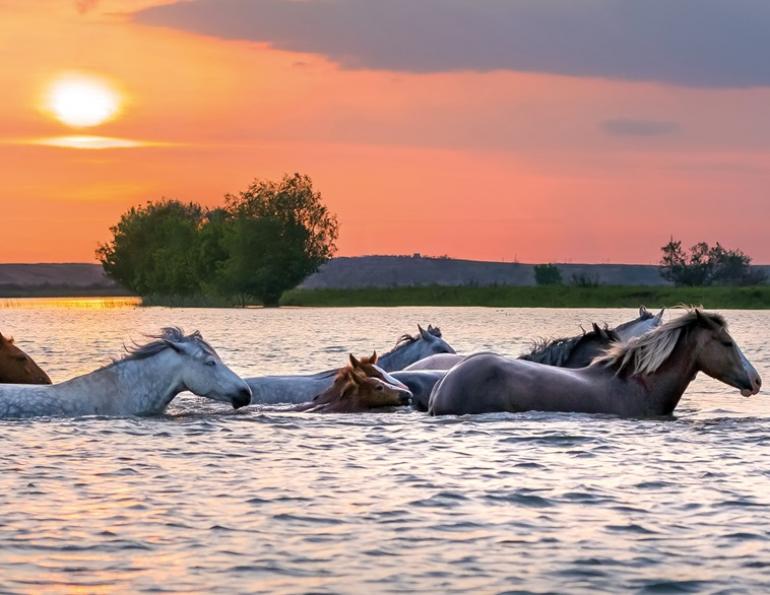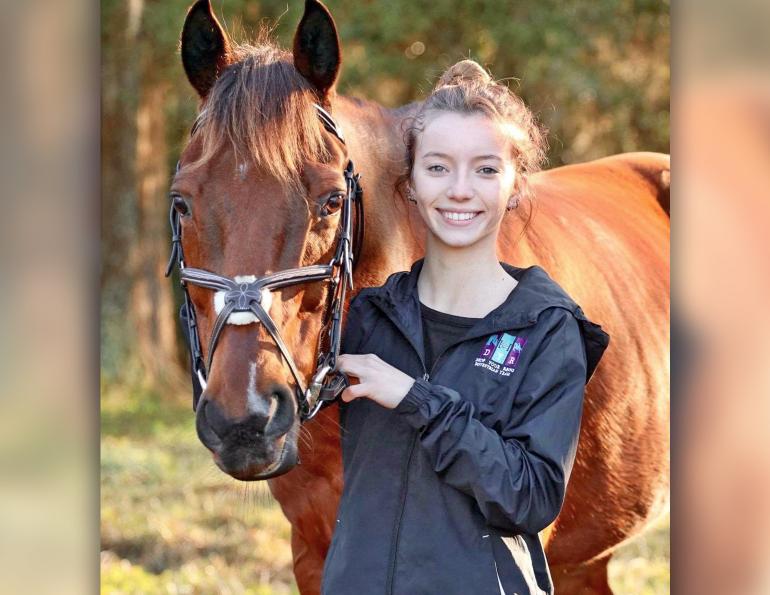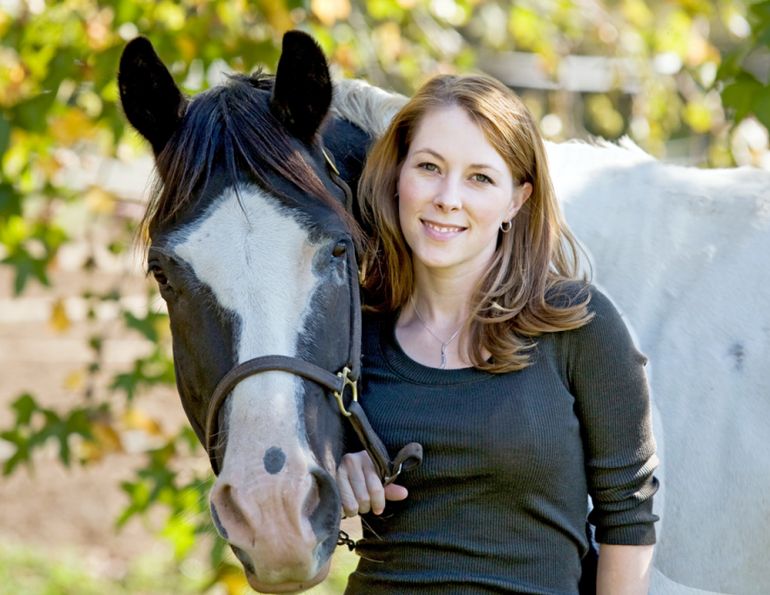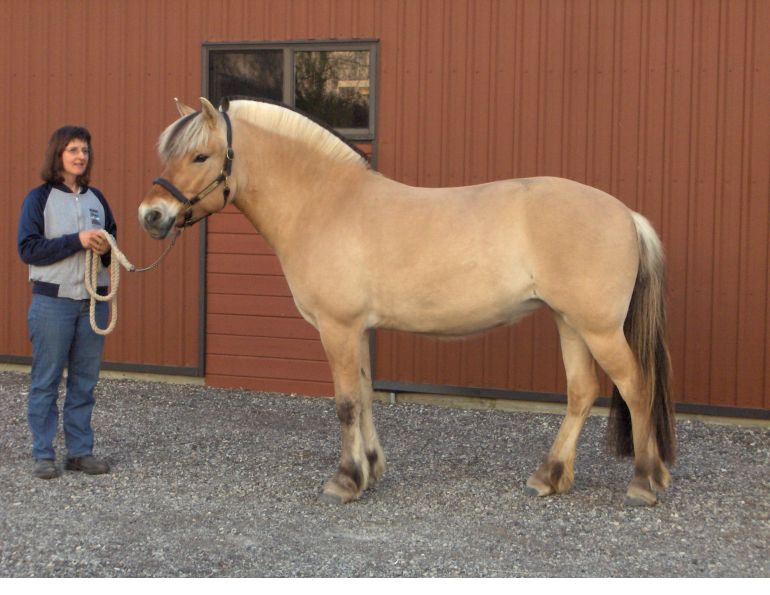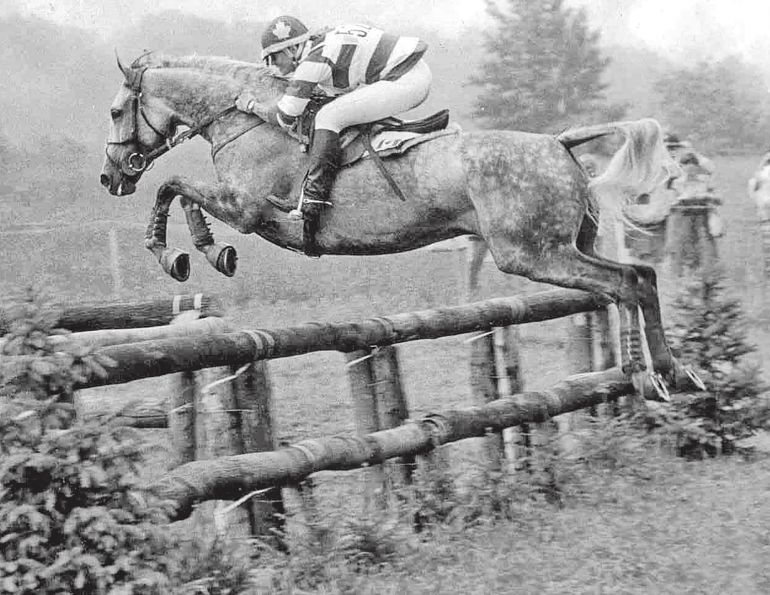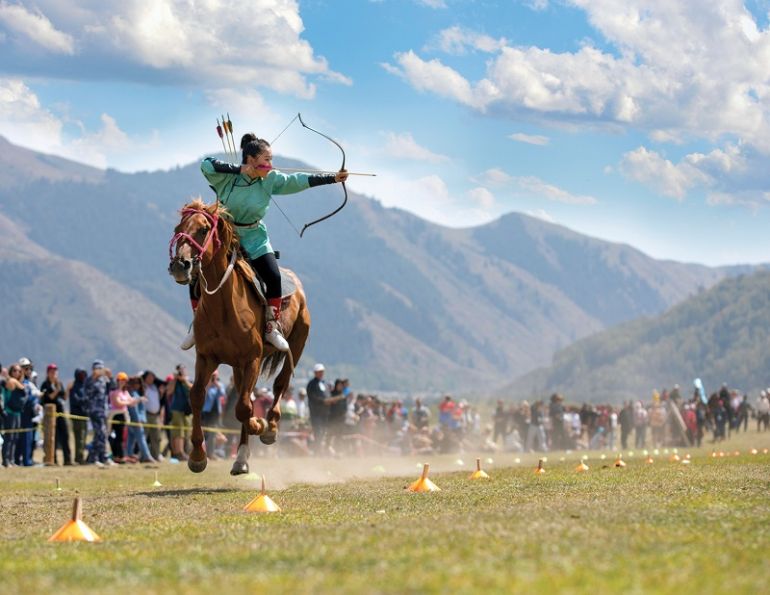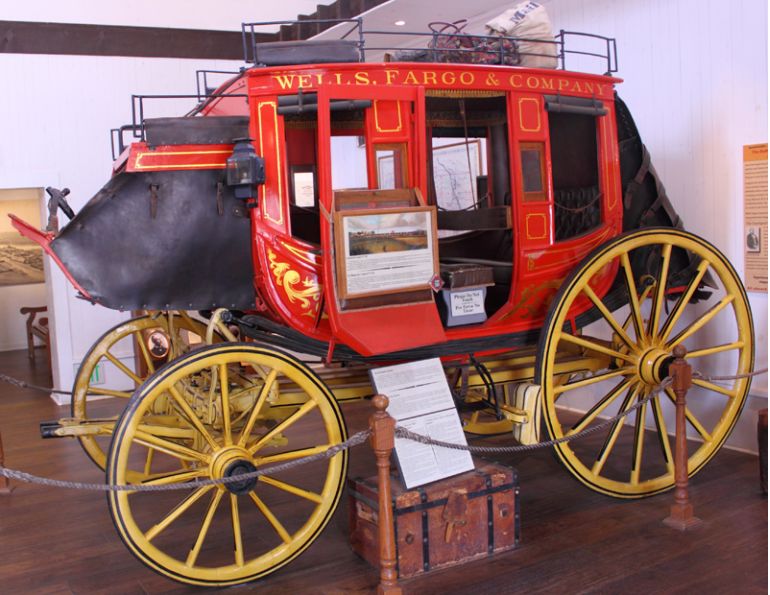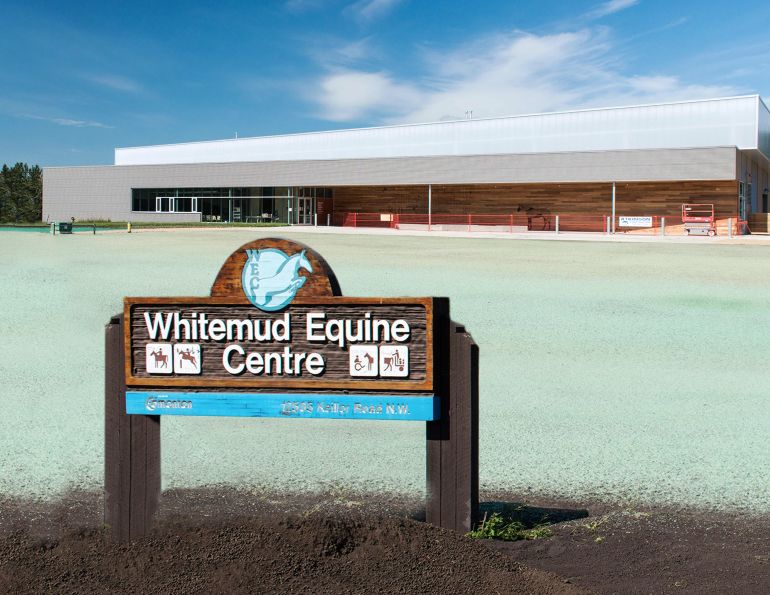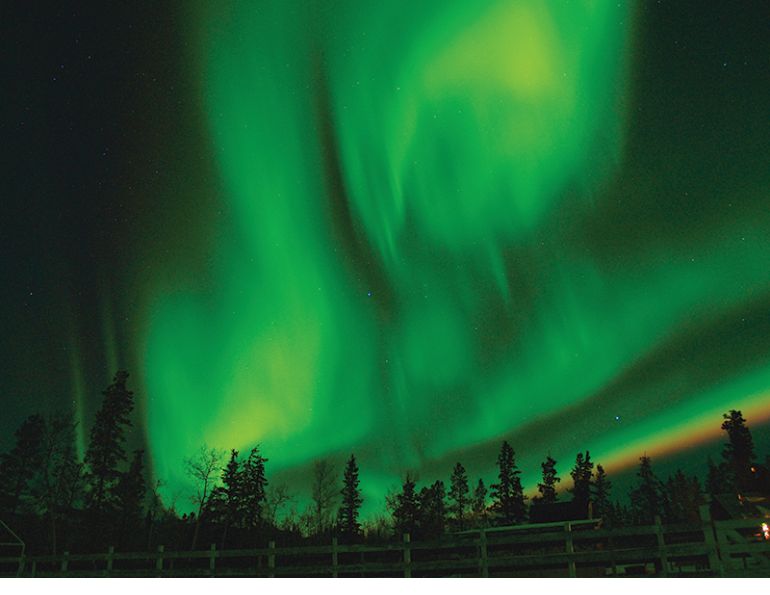By Melanie Huggett
One of the most prominent symbols of Canada is the Royal Canadian Mounted Police (RCMP) “Mountie,” wearing his red serge uniform and brown Stetson.
Put many of these Mounties on black horses, have them perform intricate formations in front of a crowd, and you have another of Canada’s most recognizable icons: the RCMP Musical Ride.
The History
The RCMP and the Musical Ride trace back to the North West Mounted Police (NWMP), which was created to maintain control of the newly acquired Canadian Northwest and to halt illegal whiskey trading on the prairies, thereby making the area safe for settlement.

Photo (left): The earliest known photo of the NWMP, taken in 1874. The men are wearing the red serge jacket, which was militia issue in the 1860s. Photo: Courtesy of www.britishempire.co.uk
When it left Dufferin, Manitoba on June 19, 1874 on the “Long March,” the NWMP boasted 318 men, most of whom were former British military. Two groups of NWMP officers, led by Inspector W.D. Jarvis and Assistant Commissioner James Macleod, marched 1000 miles west and set up posts at Fort Edmonton, Fort Macleod, Fort Walsh, Fort Battleford, Swam River, Fort Saskatchewan, and Shoal Lake in what are now the provinces of Alberta and Saskatchewan.
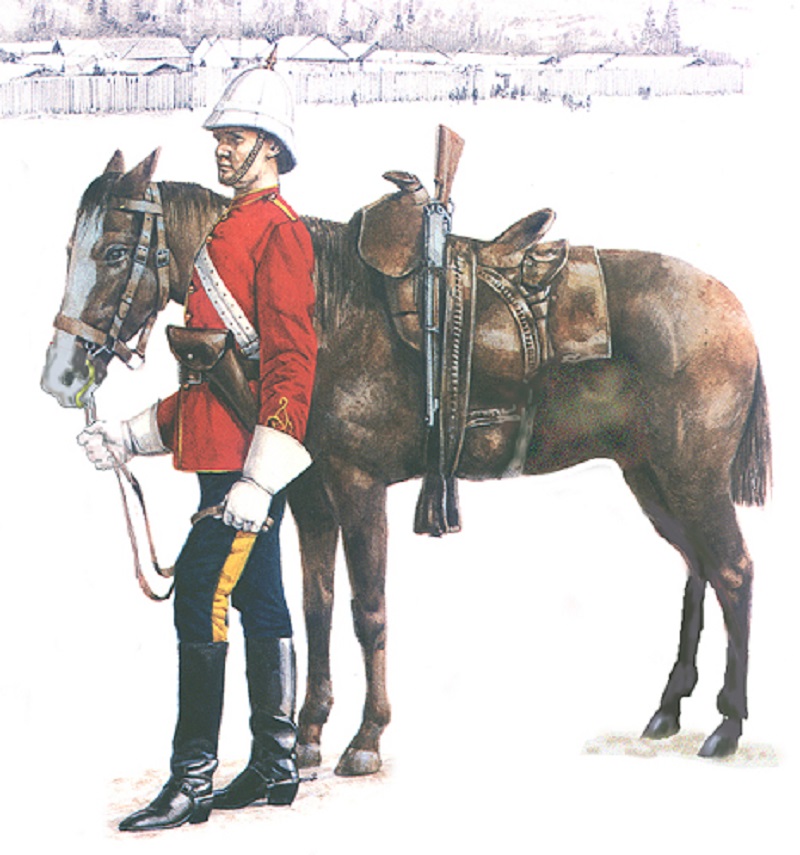
Photo (left): The uniform of the NWMP and RCMP has undergone some changes, but the red serge and blue pants have been staples since the beginning. This painting shows the uniform worn from 1876 to 1903. Photo: Courtesy of www.britishempire.co.uk
It was in these early years of the NWMP that the Musical Ride began. NWMP officers gave performances of cavalry drill maneuvers to display their riding ability and for entertainment.
Although it is believed Musical Rides occurred as early as 1876, the first officially recorded performance was in 1887 in Regina under Inspector William George Matthews, though it had no public spectators.
The reputation and prominence of the NWMP continued to grow in later decades.
In 1895, a party of NWMP was ordered to go to the Yukon to maintain order during the Klondike gold rush.
In 1904, King Edward VII bestowed the title “Royal” upon the NWMP for services during the Boer War.
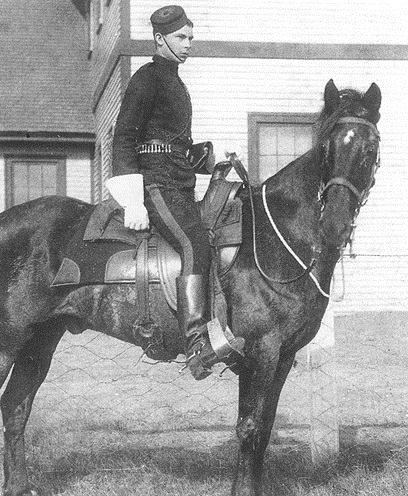
Photo (left): A NWMP Constable at Regina in 1893. Notice the “head rope,” the white rope around the horse’s neck, which was used to tie the horse and is now part of the Musical Ride horses’ tack. Photo: Courtesy of www.britishempire.co.uk
That same year the first public performances of the Musical Ride would occur; a troop trained by Inspector Frank Church performed at fairs in Winnipeg, Brandon, Qu’Appelle, and Regina, Manitoba.
In 1919, the government voted to merge the RNWMP with the Dominion Police of eastern Canada.
When the legislation became official in early 1920, the name of the force was changed to the Royal Canadian Mounted Police and headquarters was moved to Ottawa from Regina.
The RCMP stopped using horses for regular duty in the late 1930’s, the last patrol around 1936. Riding would continue to part of RCMP basic training for recruits, however, and that, along with the Musical Ride, continued with separate outfits based in Regina and Ottawa.
Performances of the Musical Ride were scattered up until 1961 when the Musical Ride became a permanent part of the RCMP and an annual performance as we know it. Today, the RCMP is unique in the world as the only policing body to serve nationally, federally, provincially, and municipally.
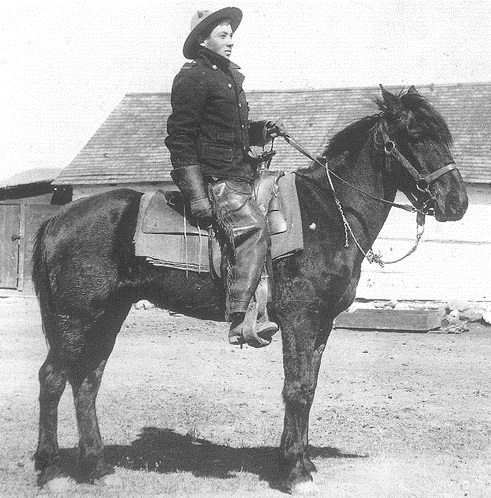
Photo (left): A NWMP Constable at Writing-on-Stone Post. He is wearing the wide, flat brimmed Stetson hat that was likely introduced by Sam Steele. Photo: Courtesy of www.britishempire.co.uk
It provides policing services federally to all of Canada, as well as policing for eight provinces (all except Ontario and Quebec), all three territories, 190 municipalities, 184 aboriginal communities, and three international airports.
The Musical Ride, through its performances across the country, promotes the RCMP’s image, delivers their community policing messages, and raises hundreds of thousands of dollars for various charities within the communities the Ride travels to.
The Riders
All riders in the Musical Ride are police officers. After completing at least two years of active police work, officers may apply to become a part of the Ride.
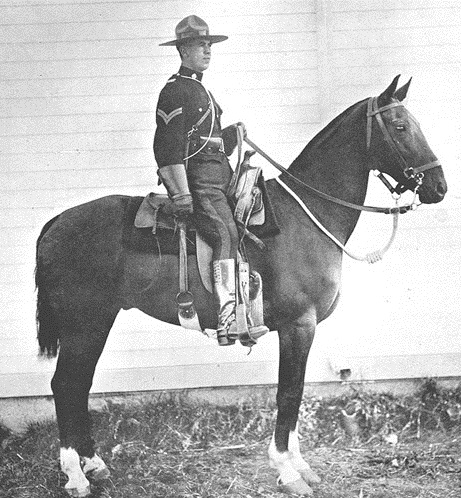
Photo (left): This photo from around 1925 shows an RCMP Corporal in full dress. The Corporal’s uniform is almost identical to that worn by the Musical Ride officers today. Photo: Courtesy of www.britishempire.co.uk
Out of approximately 800 applications, only 45 are chosen to take part in a five week Basic Equitation Course in Ottawa, where the candidates are evaluated on riding ability and aptitude, conduct, relationship with other members, initiative and effort, appearance, attendance, and responsibility and reliability.
Twelve to 15 officers are then chosen from those 45 to take part in the Ride.
The officers will then go through a six month Intermediate Equitation Course before replacing officers returning to their regular duties.
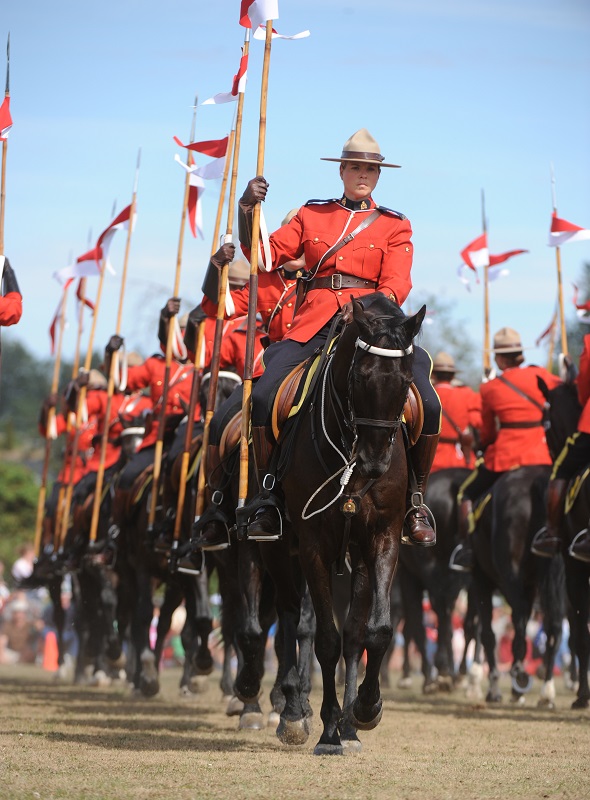
Photo (left): Women have been allowed in the RCMP only since 1974. Nowadays, many of the officer riders on the Musical Ride are female. Photo: Robin Duncan Photography
Once accepted, the officers stay on for three years, giving an annual rotation of approximately one third of the riders.
Training takes place from January to April in Ottawa. It takes approximately 16 weeks of practice to put together a Musical Ride show.
RCMP officers, such as Sgt. Major Bill Stewart and Sgt. Len Klimpke, act as riding instructors.
“Training is a lot of hard work,” said Cst. Gurdip “Paul” Rattan of Montreal, Quebec, who joined the Ride this year.
The Horses
The horses are the heart of the Musical Ride and have been an important part of the RCMP since its beginning with the NWMP, when horses were used for transport and patrols.

Photo (left): The RCMP horses are Thoroughbreds, Hanoverians, and crosses of the two. Photo: Robin Duncan Photography
The horses of the NWMP were of varying colour and often much smaller than today’s mounts; they needed to be hardy and tough to survive the often harsh conditions of the West.
In 1939, the RCMP set up a breeding program at Depot Division in Regina in order to supply the RCMP with enough black horses; in 1938, Commissioner S.T. Wood had ordered the RCMP to use only black mounts after being impressed at how the red RCMP tunics looked against black coats. In 1942 the breeding program was moved to Fort Walsh, Saskatchewan, and then finally Pakenham, Ontario in 1968.
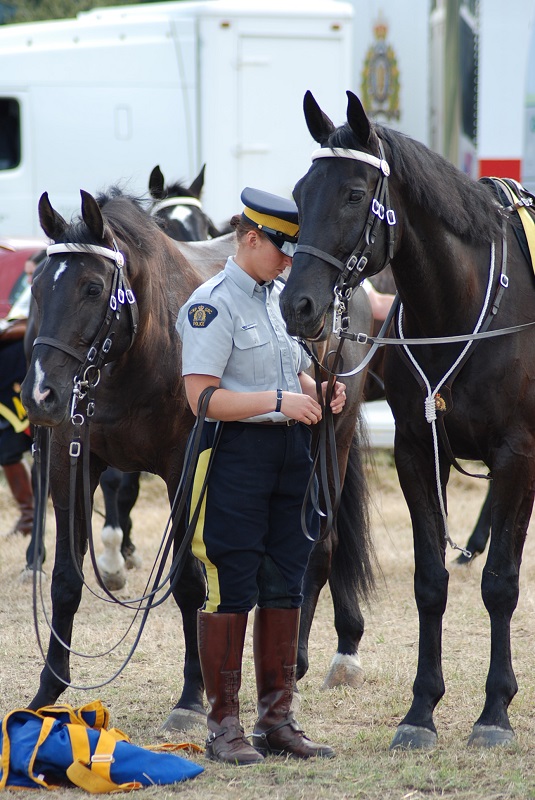
Photo (left): The Musical Ride horses are bred primarily for temperament, colour, and conformation. It’s important they have docile and willing temperaments in order to be able to deal with constantly changing sights and sounds, and huge crowds. Photo: Melanie Huggett
Today, the horses are bred primarily for colour, temperament, and conformation. In the past they were primarily Thoroughbreds, but in 1989, black Hanoverian mares and stallions were bought to improve the program. Currently, there are approximately 27 broodmares, which are bred by artificial insemination 90 percent of the time.
“The Ride chose to use Warmbloods because of their good temperaments,” says Marc Rochon, one of two farriers that work for the RCMP Musical Ride. “They are very calm.” Working in front of large crowds in various locations requires the horses be docile and good natured.
They must also be athletic, with the stamina, substance, and conformation to be able to perform the intricate movements required in the Musical Ride performance. Typically the horses stand between 16 and 17 hands, though the largest horse currently on the Ride is 17.3 hands high.
Young horses, called “remounts,” live at the 140 acre Pakenham breeding farm, where they develop and mature until three years of age. They are then moved to RCMP Rockcliff Stables in Ottawa to begin their training.
The training program is based on classical riding and is similar to that used at riding schools around the world. The horses in training are exposed to a variety of stimuli so they are able to perform in front of large crowds, in parades, in traffic, and as Royal escorts.
At six years old, the horses begin specialty Musical Ride training and take their first trips with the Ride troup. They will remain a part of the Ride for as long as they are healthy, often past 20 years of age.
About 200 horses are owned by the RCMP Musical Ride. Each horse is identified with a regimental number and name. Foals born the same year will all have names beginning with the same letter; then the next letter of the alphabet is used the following year, and so on (excluding certain letters such as Q, X, U, Y, and Z). The annual “Name the Foal Contest” runs in the spring and gives the public the chance to name six of that year’s foals.
However, there are some horses that don’t make the cut. This may be due to simply being born the wrong colour — not black or with too much white — or because they are too high strung, can’t handle the constant travelling, or dislike crowds. Only ten horses are brought into training each year. Those that don’t make it are auctioned off in the fall.
Of those that do make the cut, 36 travel on the Ride each year: 32 take part in each performance, one is ridden by the Officer in Charge, and three extra horses act as replacements if another gets sick or lame. There are also a number of horses who stay at the Rockcliff facility as school horses.
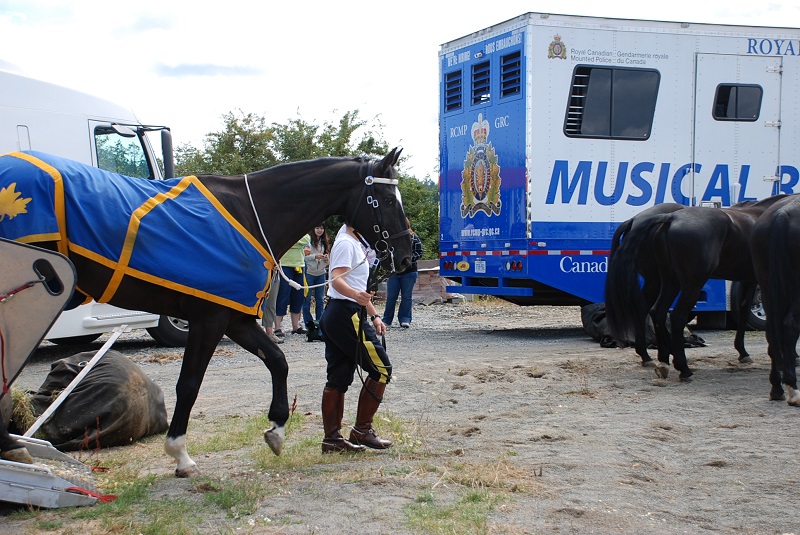
Photo (left): Three trailers transport the 36 horses that travel with the Musical Ride. A fourth trailer carries equipment such as tack and uniforms. Photo: Melanie Huggett
The utmost care is taken to ensure the horses stay healthy. “Keeping the horses sound is extremely important,” says Rochon, who travels with the Ride to keep hooves in good shape. Every horse is shod on all fours to keep their feet in good condition over the varying terrain they must perform on, such as grass, pavement, gravel, and sand. There are also strict guidelines that hosting facilities must follow, including provided adequate shelter and feed for the horses. Three large RCMP trailers carry the horses from town to town, plus a fourth containing equipment. When at home in Ottawa, the horses live in box stalls (too much turnout would fade their coats, says Rochon). They are fed hay and oats four times a day.
There are no grooms that travel with the Ride. Rather, the officers care for their mounts, including grooming, tacking up, feeding, watering, mucking out stalls, and warming and cooling out before and after each ride.
The Uniform
The ceremonial uniform of the RCMP and its horses is perhaps one of the most recognized in the world.
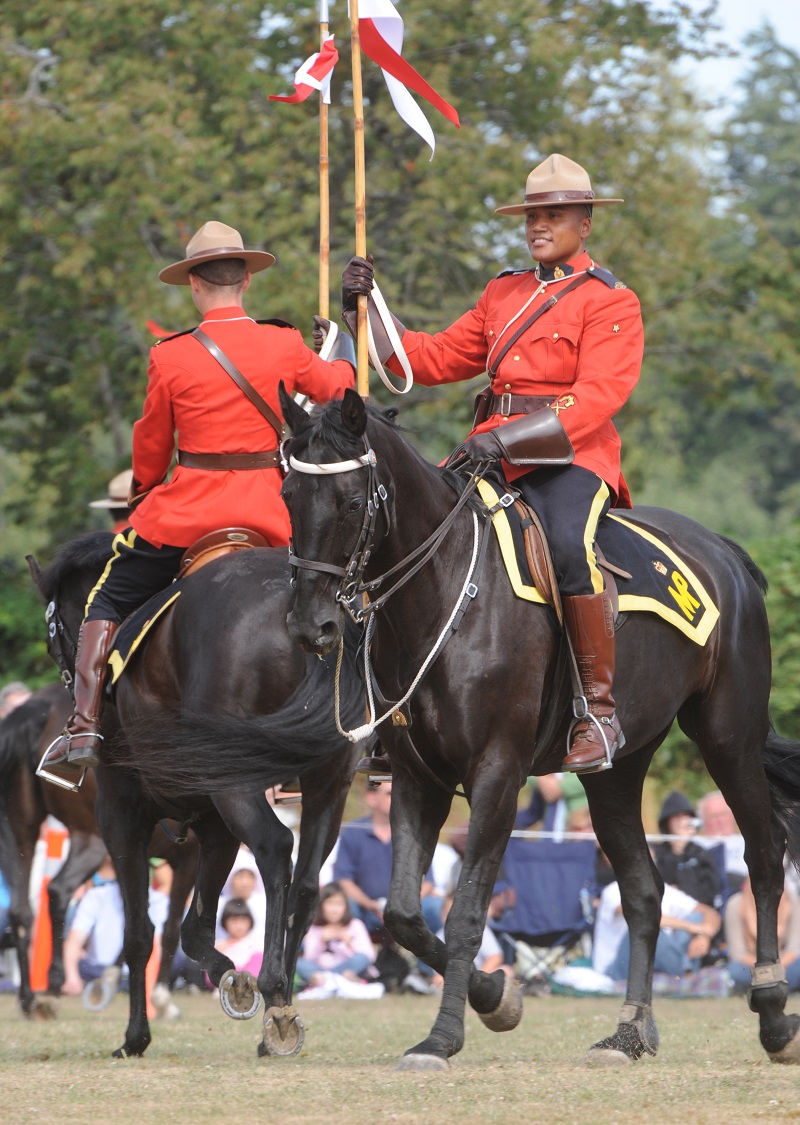
Photo (left): The fused letters “MP” on the saddle blanket or “shabracque” are the registered RCMP brand. The horses used to be branded on their shoulder, but the RCMP then switched to lip tattoos. Nowadays, microchips are implanted in each horse as a form of permanent identification. Photo: Robin Duncan Photography
Officers under the rank of inspector wear blue gorget on the collar, while officers of inspector rank and above have a solid blue collar and blue pointed sleeve cuffs.
The riders carry lances, while the Officer in Charge carries a sword.
The horses also wear a uniform, which consists of a double bridle with a white browband, the white neck strap or “head rope,” and English style saddles.
The horses’ royal blue saddle blankets, called “Shabrack” or “Shabracque,” are emblazoned in yellow with the fused letters MP, which is the RCMP’s registered brand (before 1950 the horses themselves were branded, but nowadays a microchip is used as permanent identification).
The horses also have a maple leaf brushed onto their rumps; this is done with a wet brush and a stencil before each performance.
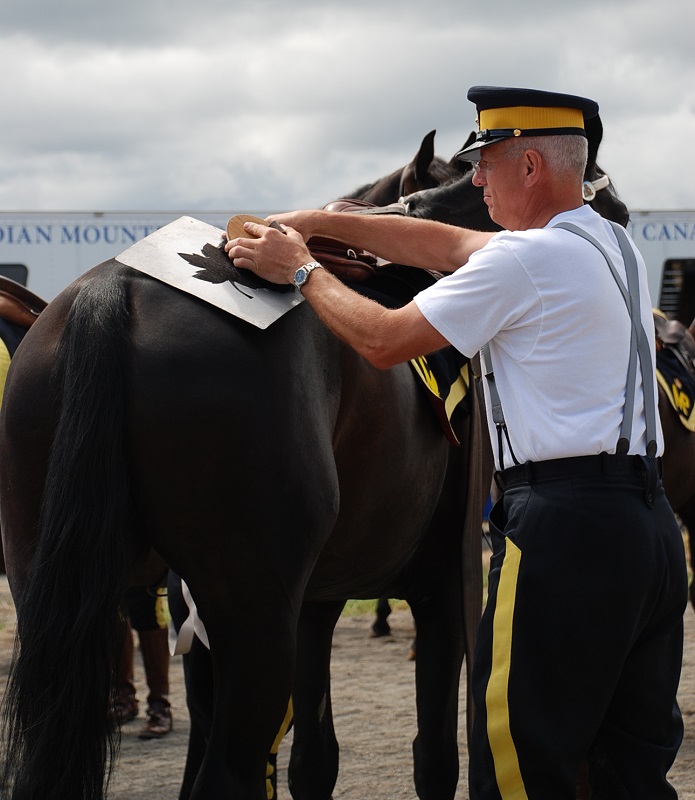
Photo (left): Before each performance, a Canadian flag is brushed onto the horses’ rears using a stencil and a wet brush. Photo: Melanie Huggett
A saddler is employed by the RCMP to maintain and repair all horses’ tack.
He also makes all the leather goods for the Musical Ride, except for the saddles themselves, which are made by the German saddle maker Stubben.
Much of the Mounties uniform dates back to the NWMP.
Being of military descent, the NWMP was originally kitted out from militia stores.
The red tunic was chosen to emphasize the British nature of the NWMP, and to make it distinct from the blue American military uniforms.
The Stetson was not adopted officially until 1904.
It is believed that Sam Steele, one of the original NWMP, introduced the style of hat, as it was a practical item to wear while on patrol, unlike the official headdress of a pith helmet. The lance is also of NWMP origin.
It was carried by the men on the Long March as it was believed that lances would be intimidating.
The NWMP also carried the lance on patrols.
Finally, the horse’s white head rope was used by the NWMP to tie the horses when dismounted.
The Performance
Between May and October, the Ride travels to communities in two provinces which are chosen each year.

Photo (left): Inspector Marty Chesser, the Officer in Charge, leads the Musical Ride for the salute at the beginning and end of each performance. He carries a sword instead of a lance. Photo: Robin Duncan Photography
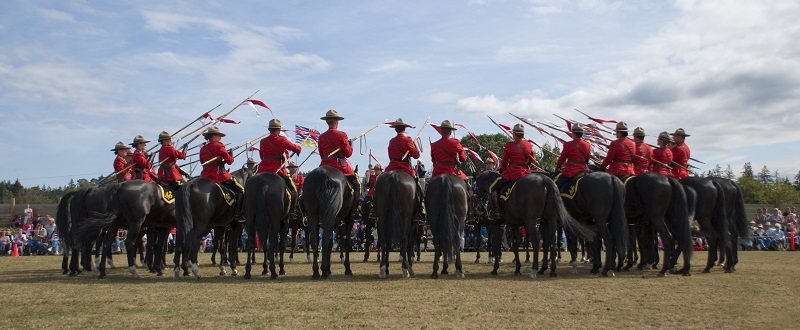
In total, the Musical Ride performs at 40 to 50 locations each year, often giving multiple performances at each.
This requires a large traveling team of officers which includes 36 horses, 36 riders including an Officer in Charge, a farrier, a technical production manager, and three noncommissioned officers (NCOs).
“The travel is difficult if you are married and have a family,” says Cst. Rattan.
The performance involves 32 horse-rider pairs doing intricate manoeuvers and patterns at all three gaits. Typically, the officers will ride the same horse for the duration of a tour.
One of the most famous formations is called the “Dome,” in which horses face each other in a circle with riders pointing their lance tips inwards. The dome was once featured on the back of the Canadian 50 dollar bill.
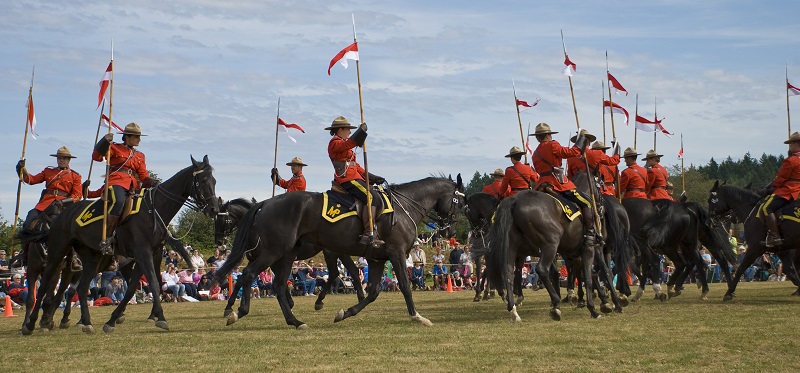
The intricate patterns performed during the Musical Ride performance are based on cavalry manoeuvers and stem from the RCMP’s military history. Photos: Melanie Huggett

The charge at the end of every performance is extremely exciting, as all 32 horses gallop across the field while the riders point their lances forwards.
A highlight of each performance for spectators is undoubtedly the “charge” at the end. Officers line their horses up at one end of the field, and, at the calling of “CHARGE!” gallop forward with lances lowered.
An RCMP Musical Ride performance is a splendor to watch. It is exciting, full of pageantry, and, above all, truly Canadian.
Main photo: Robin Duncan Photography - There are 32 riders and 32 horses in the Musical Ride performance. The RCMP horses are Thoroughbreds, Hanoverians, and crosses of the two.



